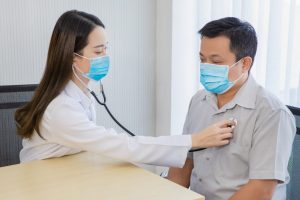Do kids need vaccines if they’re doing virtual learning or homeschool this fall?
School might look a little different in the U.S. this fall. The COVID-19 pandemic has forced communities to make some tough choices, and many families will be keeping their kids home at least some of this school year while they take online classes or opt for homeschooling. Without in-person learning, parents might wonder whether they need to do all the usual back-to-school errands — including vaccinations.
 Vaccination coverage for children took a hit in the spring of 2020. Many families stayed home in a necessary attempt to flatten the curve of COVID-19. While that meant avoiding eating at restaurants, skipping the movie theater and canceling trips, it also often included delaying routine doctor’s appointments like general checkups, well-visits and vaccinations.
Vaccination coverage for children took a hit in the spring of 2020. Many families stayed home in a necessary attempt to flatten the curve of COVID-19. While that meant avoiding eating at restaurants, skipping the movie theater and canceling trips, it also often included delaying routine doctor’s appointments like general checkups, well-visits and vaccinations.
To protect healthcare professionals and patients from coronavirus, many clinics and medical offices have implemented strict precautions, leading vaccination rates to recover somewhat in the months that followed. But rates still lag behind previous years’.
It’s easy to see why. When there’s a pandemic happening and kids stay home, parents might wonder… Are vaccinations really important right now? It turns out vaccinations have never been more crucial. Here’s why.
Vaccine-Preventable Diseases Could Make the COVID-19 Crisis Worse
 Coronavirus has stretched the U.S. healthcare capacity to its limits. Resources had to be diverted to address the coronavirus crisis, and months of battling COVID-19 have left healthcare professionals and public health workers burnt out and exhausted. The last thing these frontline workers need is to manage a vaccine-preventable disease outbreak on top of the COVID-19 pandemic.
Coronavirus has stretched the U.S. healthcare capacity to its limits. Resources had to be diverted to address the coronavirus crisis, and months of battling COVID-19 have left healthcare professionals and public health workers burnt out and exhausted. The last thing these frontline workers need is to manage a vaccine-preventable disease outbreak on top of the COVID-19 pandemic.
But they might have to. As schools reopen and fatigue leads some to relax their social distancing and masking precautions, flu season could mean more infections spreading in schools and businesses. While we can’t prevent every cough or sniffle, vaccinations can protect kids and their families from diseases like influenza and whooping cough, which can cause symptoms similar to COVID-19. In areas where communities have to rely on symptoms to decide who should quarantine, the similarity between flu and COVID-19 illnesses could result in more stress for everyone.
It could also divert badly needed resources to contain another outbreak. One analysis, for example, found that responding to a single measles case could cost a community as much as $142,000. A full-blown outbreak in an under-vaccinated community could mean spending millions.
With high numbers of COVID-19 in many parts of the U.S., protecting ourselves from other diseases will help minimize disruption and ensure public health and medical professionals have enough time and resources to focus on getting coronavirus outbreaks under control.
School Isn’t the Only Place Kids Come Across Infectious Diseases
Many states still require virtual students to be up to date on specific vaccinations. But even if you’re homeschooling or your state has chosen to wave vaccination requirements this year, your doctor will likely recommend your family get vaccinated with all routinely recommended vaccines — not just those required for school. That’s because schools aren’t the only places a child might come across an infectious disease, and communities will need high vaccination rates to protect against outbreaks when businesses and places of worship reopen and in-person schooling resumes.
“Required” Vaccines Aren’t More Important Than “Recommended” Ones
Schools don’t require all vaccines for their students, but that doesn’t make non-required vaccines — like HPV and flu vaccines — any less essential.
School vaccine requirements come from the state and are the minimum vaccinations necessary to enroll in school. These mandates are different from the more comprehensive vaccination schedule your healthcare provider relies on, which is created by the Advisory Committee on Immunization Practices (ACIP).
The ACIP, which is made up of medical and public health experts, meets several times a year to discuss the latest research on vaccines and vaccine-preventable diseases and to make recommendations on who should be vaccinated and at what ages. All of these recommendations are based on science. The ACIP only adds a vaccination to the routine schedule if they think everyone in that age group should get it, with few exceptions.* If a vaccine only matters for certain high-risk groups, the ACIP says so.
Every year, the CDC publishes updated child, preteen/teen, and adult immunization schedules based on the ACIP’s recommendations. The schedules are also approved by the American Academy of Pediatrics (AAP), the American Academy of Family Physicians (AAFP), the American College of Obstetricians and Gynecologists (ACOG), the American College of Physicians (ACP) and the American College of Nurse-Midwives (ACNM).
Schools might not require vaccinations against flu or HPV, but they’re just as essential as vaccinations against measles or meningitis.
Following the CDC’s recommended vaccination schedule — whether your children are in school or not — will ensure your family is protected from dangerous diseases and will meet any and all school vaccination requirements. If you aren’t sure what vaccinations you or your child need, ask your healthcare provider right away.
—
*Certain individuals might not be able to receive certain vaccines safely due to medical conditions or allergies.